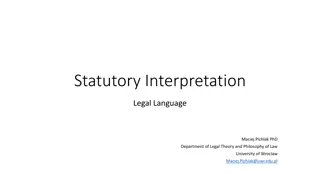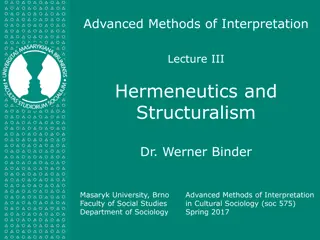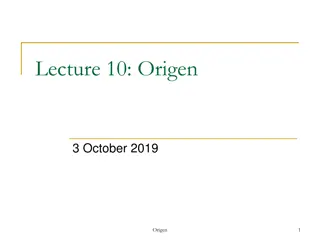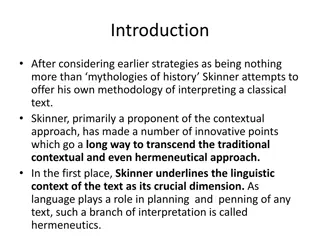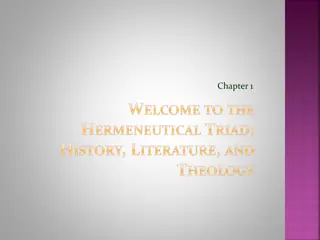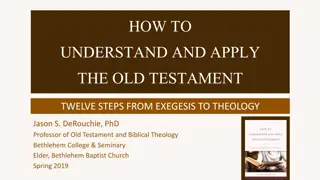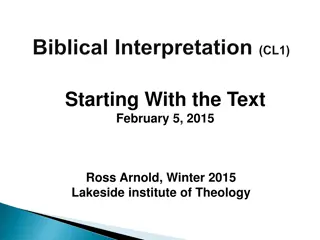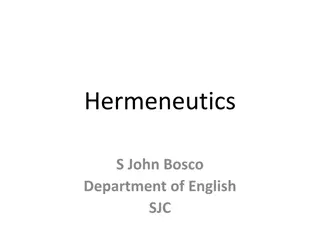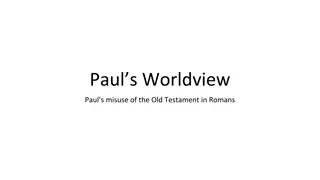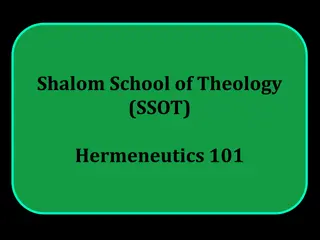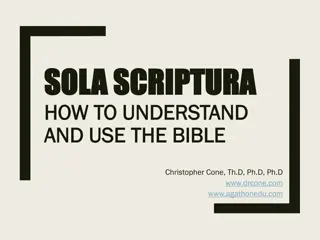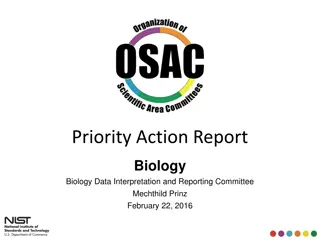Importance of Proper Hermeneutics in Biblical Interpretation
Hermeneutics, the science of biblical interpretation, is crucial in understanding and applying the Word of God accurately. It involves rules and methods to determine the intended meaning of the text. Proper hermeneutics ensures correct belief, application, and interpretation of the Bible while avoiding misinterpretation. It is essential for believers to know and communicate God's message effectively.
Download Presentation

Please find below an Image/Link to download the presentation.
The content on the website is provided AS IS for your information and personal use only. It may not be sold, licensed, or shared on other websites without obtaining consent from the author. Download presentation by click this link. If you encounter any issues during the download, it is possible that the publisher has removed the file from their server.
E N D
Presentation Transcript
Biblical Interpretation BROOKES BIBLE COLLEGE SPRING 2017 ROBERT THURMAN
Biblical Interpretation I. What is hermeneutics? A. Origin of term- "The word hermeneutics is said to have had its origin in the name Hermes, the Greek god who served as messenger for the gods. . . ." (Henry Virkler, Hermeneutics, p. 15). B. Definition "Hermeneutics is the science of Biblical interpretation. It is a science because it is guided by rules within a system. (Bernard Ramm, Protestant Biblical Interpretation, p. 1). "Hermeneutics is a science that must be applied with skill by the interpreter" (Bernard Ramm, Protestant Biblical Interpretation, p. 11). C. The rules by which we play Hermeneutics determines the methods, techniques, rules and principles which best help us determine the intended meaning of the biblical text.
Biblical Interpretation Just as a baseball player must understand the rules of the sport in order to be an effective player, the interpreter of the Bible must also abide by certain rules to make sure his or her interpretation is true to the intended meaning of the text. "Hermeneutics is essentially a codification of the processes we normally use at an unconscious level to understand the meaning of a communication" (Virkler, p. 19). II. Difference between General and Special Hermeneutics A. General Hermeneutics- The study of those rules that govern interpretation of the entire Bible. B. Special Hermeneutics- The study of those rules which govern the interpretation of specific literary genres found in the Bible, such as parables, types and prophecy.
Biblical Interpretation III. Why is understanding and applying proper Hermeneutics important? A. So we can know what God has said "This is the primary and basic need of hermeneutics: to ascertain what God has said in Sacred Scripture; to determine the meaning of the Word of God. There is no profit to us if God has spoken and we do not know what He has said. Therefore it is our responsibility to determine the meaning of what God has given to us in Sacred Scripture" (Ramm, p. 2). 1. Proper belief depends on it As believers, we must make sure we are interpreting God's Word accurately. We must do so in order to have correct views concerning salvation, Christian living and our future hope. 2. The Bible Commands it "Be diligent to present yourself approved to God as a workman who does not need to be ashamed, handling accurately the word of truth 2 Timothy 2:15
Biblical Interpretation B. So we can correctly apply what God has said "We must know the meaning of the Bible before we can know its message for today. We must understand its sense for then before we can see its significance for now" (Roy B. Zuck, Basic Bible Interpretation, p. 10). Proper interpretation is essential to proper application. If we do not interpret properly, we may end up applying the Bible incorrectly. C. So we can avoid misinterpreting the Bible We do not want to be like those who are "adulterating the word of God" (2 Cor. 4:2). Nor do we want to be like those who "distort the Scriptures "to their own destruction" (2 Peter 3:16). D. Because the Bible is our sole authority "Conservative Protestantism takes only the Bible as authoritative, there is no secondary means of making clear the meaning of the Bible. (Ramm, p. 1)
Biblical Interpretation Unlike Roman Catholicism and other groups, our divine authority comes from the Bible. Thus, there are no other authorities equal with the Bible that can interpret the Bible for us. E. Because we are dealing with an ancient book "The first five Old Testament books were written by Moses around 1400 B.C. The last book of the Bible, Revelation, was written by the Apostle John around A.D. 90. So some of the books were written about 3,400 years ago and the latest one was written about 1,900 years ago. This suggests that in hermeneutics we must seek to bridge several gaps posed by our having such an ancient book in our hands" (Zuck, pp. 15-16). 1. Language gap The Bible was written in Hebrew, Aramaic, and Greek. To formulate rules to bridge this gap is one of the most important tasks of Biblical hermeneutics (Ramm, p. 5).
Biblical Interpretation 2. Time gap "Because of the extensive time gap between ourselves and the writers and initial readers of the Bible, a huge chasm exists. Since we were not there, we cannot talk with the authors and with the initial hearers and readers to discover firsthand the meaning of what they wrote" (Zuck, p. 16). For example: Jonah's lack of concern for the Ninevites is better understood when we realize the extreme cruelty and sinfulness ofthe people of Ninevah, and the threat they posed to Jonah s people. 3. Cultural gap "There is also the culture-gap between our times and Biblical times which the interpreter must bridge. Culture, in the anthropological sense, is all the ways and means, material and social, whereby a given people carry on their existence. Until we can recreate and understand the cultural patterns of the various Biblical periods we will be handicapped in our understanding of the fuller meaning of Scripture" (Ramm, p. 5). "Great differences exist between the way people in the Western world do things and think and the way people in Bible lands lived and thought. Therefore it is important to know the cultures and customs of peoples in Bible times. Often faulty interpretations stem from an ignorance of those customs" (Zuck, p. 16).
Biblical Interpretation 4. Geographical gap "Most readers of the Bible today live thousands of miles from the countries where Bible events took place. The Middle East, Egypt, and the southern Mediterranean nations of present-day Europe were the places where Bible people lived and traveled. These extend from Babylon in present-day Iraq to Rome (and possibly Spain, if Paul traveled there). This geographical distance puts us at a disadvantage (Zuck, p. 16). IV. The relationship between hermeneutics and other fields Hermeneutics is not isolated from other areas of biblical study. A. Canonicity The determination of which books were inspired by the Holy Spirit and, thus, are to be regarded as Scripture.
Biblical Interpretation B. Biblical Introduction Biblical Introduction deals with many issues related to each book of the Bible. It deals with issues such as the historical background of the writers, readers, locations, cultures and philosophies associated with each book. C. Textual Criticism "This is the process of study whereby one establishes the exact words that were written by the original author, based on the thousands of documents resulting from the copyings of the originals" (Robert L. Thomas, Introduction to Exegesis, p. 13). D. Exegesis "Exegesis may be defined as the determination of the meaning of the biblical text in its historical and literary contexts. . . . Exegesis is the actual interpretation of the Bible, and hermeneutics consists of the principles by which the meaning is determined" (Zuck, pp. 19- 20).
Biblical Interpretation E. Biblical Theology "Biblical theology is the study of divine revelation as it was given throughout the Old and New Testament. It asks the question, 'How did this specific revelation add to the knowledge that believers already possessed at that time?' It attempts to show the development of theological knowledge throughout the Old and New Testament era" (Virkler, p. 18). F. Systematic Theology "Systematic Theology organizes the biblical data in a logical rather than historical manner. It attempts to place together all the information on a give topic (e.g., the nature of God, the nature of the afterlife, the ministry of angels) so that we may understand the totality of God's revelation to us on that topic. Biblical and systematic theology are complementary fields" (Virkler, p. 18).
Biblical Interpretation G. Exposition Exposition is the task of presenting the meaning of the biblical text exactly as it was intended by God and by the human author of Scripture. V. Qualifications For Hermeneutics A. Must be born again (1 Cor. 2:14) No one can fully comprehend the meaning of the Bible unless he is regenerate. The unsaved person is spiritually blind (2 Cor. 4:4) and dead (Eph. 2:2). B. Must have an interest in God's Word C. Must have a prayerful attitude and humility D. Must have an obedient attitude E. Must rely on the Holy Spirit F. Must be objective "The Bible student must also approach the Scriptures with sound judgment and reason, seeking to be as objective in his approach to the Bible as possible, without coming to the Scriptures with prejudice or preconceived notions" (Zuck, p. 25).
Biblical Interpretation The History of Interpretation I. The History of Interpretation A. The importance of knowing the History of Interpretation "A knowledge of the history of biblical interpretation is of inestimable value to the student of the Holy Scriptures. It serves to guard against errors and exhibits the activity and efforts of the human mind in its search after truth and in relation to noblest themes. It shows what influences have led to the misunderstanding of God's word, and how acute minds, carried away by a misconception of the nature of the Bible, have sought mystic and manifold meanings in its content (Milton S. Terry, Biblical Hermeneutics, p. 31). 1. Learn from mistakes of others "By observing the mistakes of those who have preceded us, we can be more aware of the possible dangers when we are similarly tempted. Santayana's adage that 'he who doesn't learn from history is bound to repeat it' is as applicable to the field of interpretation as it is to any other field" (Virkler, p. 48).
Biblical Interpretation 2. Balanced view of Church Fathers Many great Christians (e.g., Origen, Augustine, Luther) understood and prescribed better hermeneutical principles than they practiced. B. Two Schools of Interpretation "Throughout the centuries since God revealed the Scriptures, there have been a number of approaches to the study of God's Word" (Virkler,p. 47). Literal School Gives to words the same meaning they would have in normal, ordinary usage Allegorical School Gives to words hidden and deeper meanings that were not conceived of by the original author
Biblical Interpretation 1. The Literal School "More orthodox interpreters have emphasized the importance of a literal interpretation, by which they meant interpreting God's Word the way one interprets normal human communication." (Virkler, p. 47) "The literal method of interpretation is that method that gives to each word the same exact basic meaning it would have in normal, ordinary, customary usage, whether employed in writing, speaking or thinking. It is called the literal-grammatical-historical method to emphasize the fact that the meaning is to be determined by both grammatical and historical considerations" (Dwight Pentecost, Things to Come, p. 9). 2. The Allegorical School "The definition of the allegorical method is as follows: The allegorical method regards the literal, grammatical, historical sense of a passage as a mere vehicle for getting underneath to a hidden meaning which is deeper, more profound, and more spiritual." (James Rosscup, Hermeneutics, syllabus for The Master's Seminary, 1988, p. 25)
Biblical Interpretation With the allegorical method, what the original writer of Scripture is trying to say is passed over in search of a deeper and more spiritual meaning. II. Interpretation Throughout History A. Ezra (ca. 445 B.C.) "It is generally agreed by all students of the history of hermeneutics that interpretation began at the time of the return of Israel from the Babylonian exile under Ezra as recorded in Nehemiah 8:1-8. Such interpretation was necessary, first of all, because of the long period in Israel's history in which the Mosaic law was forgotten and neglected. . . . It was necessary, further, because the Jews had replaced their native tongue with Aramaic while in exile. Upon their return the Scriptures were unintelligible to them. It was necessary for Ezra to explain the forgotten and unintelligible Scriptures to the people. It can hardly be questioned but that Ezra's interpretation was a literal interpretation of what had been written." (Pentecost, p. 16) (emphasis mine) "Herein lies the recorded birth of literal Bible exegesis and the formal exposition of God's Word" (Paul Lee Tan, The Interpretation of Prophecy, p. 41).
Biblical Interpretation B. Jewish interpretation during the Intertestamental Era (400 B.C. A.D. 10) 1. The rise of Letterism At first, the interpreters after Ezra kept to a normal, literal method of interpreting Scripture. However, as Paul Lee Tan says, "The splendid Bible study movement started under Ezra later deteriorated under the rabbis into a school which fanatically worshiped the bare letters of Scripture" (Tan, p. 41). This letterism placed undo focus on the letters of the words of Scripture. As a result the author's intended meaning was often overlooked and replaced by fanciful speculation. 2. The School of Rabbi Hillel (70 B.C. A.D. 10(?)) Rabbi Hillel was a prominent leader among the Jews of Palestine who established a school named after him in Jerusalem. "He set up seven hermeneutical rules by which the mass of Jewish traditions could be deduced from the Scripture. Although some of Hillel's rules were valid and sensible, most opened the floodgates to excessive allegorization" (Tan, p. 41).
Biblical Interpretation a. Ex: "'Eliezer' has the value of 318 in the Hebrew. Since Abraham also had 318 servants, the rabbis interpreted this to mean that Eliezer was equal to all the rest of Abraham's servants" (Tan, p. 43). b. Ex: there must be 903 ways of dying because the Hebrew word for death in Psalm 68:20 has a numerical value of 903 (Tan, p. 43). c. Critiquing Letterism "There is one major lesson to be learned from rabbinical exegesis: the evils of letterism. In the exaltation of the very letters of Scripture the true meaning of the Scriptures was lost" (Ramm, p. 48). Opponents of a literal interpretation of prophecy often point to the hyper-literalists of Jewish Rabbinism as proof that one can be too literal with the Scriptures. But this is not valid. "The Jewish rabbis did not really misuse the literal method. Literalism and letterism are two different things. . . . Letterism is the premature (not extreme) form of literalism. The interpreter who is properly conversant with the literal method of interpretation can never be too literal in interpreting God's Word" (Tan, p. 45).
Biblical Interpretation C. The rise of Allegorism (B.C.) 1. Greek Allegorists "It may seem strange to list. . . the Greek school, but this is necessary to understand the historical origins of allegorical interpretation. The Greeks were not concerned with the Sacred Scripture but with their own writings, and in this sense it is improper to classify them within the context of Biblical interpretation. But in that their allegorical method was adopted by both Jew and Christian they deserve this special attention" (Ramm, p. 24). Thus, allegorical interpretation stems from pagan sources. How did allegorizing start? "Greek philosophers while appreciating the ancient Greek writings of Homer (ninth century B.C.) And Hesiod (eighth century B.C.), were embarrassed by the immoral conduct and by the anthropomorphisms of the fanciful gods of Greek mythology in those writings. For instance Phadra fell in love with her stepson Hippolytus. Zeus had to defeat the three-headed Typhon...
Biblical Interpretation . . . How could the Greek philosophers revere these writings and at the same time accept the elements in their writings. . . . To get around this problem, the philosophers allegorized the stories, looking for hidden meanings underneath the literal writings. . . . The Greek writers in this way were using allegorizing for apologetic purposes, to keep the Greek poets from being ridiculed" (Zuck, pp. 29-30). 2. Jewish Allegorists in Alexandria Jews in Alexandria, Egypt were influenced by Greek philosophy. But they too faced a problem: How could they accept the Old Testament and also Greek philosophy, particularly that of Plato? Their solution was to do the same as the Greek philosophers themselves, namely, to allegorize the Old Testament. The Alexandrian Jews were concerned about anthropomorphisms and immoralities in the Old Testament, just as the Greek philosophers were embarrassed by those elements in Homer and Hesiod. Because of the many Greeks living in Alexandria, the Jews were readily influenced by them, and easily took up allegorizing the Old Testament as a way of accepting it along with Greek philosophy.
Biblical Interpretation They too saw this as a means of apologetics, a way to defend the Old Testament to the Greeks." Accounts thought too embarrassing include: a. Exodus 15:3 "The Lord is a man of war." b. Exodus 32:14: "And the Lord repented of the evil." c. Lot's incest d. Noah's drunkenness 3. Philo "Philo (ca. 20 B.C. ca. A.D. 54) is the best known Alexandrian Jewish allegorizer. He too was influenced by Greek philosophy, yet because of his piety as a Jew he sought to defend the Old Testament to Greeks and even more so, to fellow Jews.
Biblical Interpretation Philo was led to allegorize the Old Testament rather than always following a literal method of interpretation because of his desire to avoid contradictions and blasphemies. Philo stated that allegorizing is necessary to avoid seemingly unworthy statements of God, or seemingly contradictory statements in the Old Testament" (Zuck, p. 32). a. Ex. A statement unworthy of God. "Adam hid himself from God." To Philo this dishonors God because God sees all things. b. Ex. A contradiction. Cain had a wife c. Ex. Four heads The four heads of the river going out of Eden are the virtues of prudence, courage, temperance, and justice. Jesus' interpretation of the Old Testament Jesus used the normal, literal method of interpreting the Old Testament Scriptures and not the allegorical method.
Biblical Interpretation An examination of Jesus' use of the Old Testament shows: 1) He consistently treated the historical narratives as straightforward records of fact. The allusions to Abel, Noah, Abraham, Isaac, Jacob and David, for example, all seem to be intended and were understood as references to actual people and historical events; 2) When Jesus made an application of the historical record, He drew from the normal, as opposed to the allegorical, meaning of the text. He showed no tendency to divide scriptural truth into levels a superficial level based on the literal meaning of the text and a deeper truth based on some derived mystical level; 3) Jesus denounced the way the religious leaders had developed casuistic methods that set aside the very Word of God they claimed to be interpreting and replaced it with their own traditions; 4) The Scribes and Pharisees never accused Jesus of using any Scripture unnaturally or illegitimately (Taken from Virkler, p. 54).
Biblical Interpretation E. The Apostle's use of the Old Testament The apostles followed the Lord Jesus in interpreting the Old Testament literally. Though there are times when the New Testament writers seem to modify the original meaning of the Old Testament text or seem to use the Old Testament in unnatural ways, there can be no doubt that on the whole, the apostles and New Testament writers interpreted the Old Testament normally. As Virkler says, "In conclusion, the vast majority of the New Testament references to the Old Testament interpret it literally; that is, they interpret according to the commonly accepted norms for interpreting all types of communication history as history, poetry as poetry, and symbols as symbols. There is no attempt to separate the message into literal and allegorical levels. The few cases where the New Testament writers seem to interpret the Old Testament unnaturally can usually be resolved as we understand more fully the interpretive methods of biblical times" (Virkler, p. 58).
Biblical Interpretation F. The Early Church Fathers Era (A.D. 100 500) "Despite the practice of the apostles, an allegorical school of interpretation dominated the church in the succeeding centuries. This allegorization sprang from a proper motive the desire to understand the Old Testament as a Christian document. However, the allegorical method as practiced by the church fathers often neglected completely the author's intended meaning and the literal understanding of a text to develop speculations the author himself would never have recognized." (Virkler, pp. 58-59) "From these early church fathers it is obvious that while they may have started out well, they were soon influenced by allegorizing" (Zuck, p. 33).
Biblical Interpretation 1. The Alexandrian School (Allegorists) a. The Epistle of Barnabas (Early 2nd century, spurious. Written probably by some Alexandrian Christian influenced by Philo.) Concerning the reference to the 318 servants of Abraham (Gen. 14:14), Barnabas believed, "The Greek letter t stands for 300 and represents the cross, and the letters I and e represent 10 and 8 respectively, and are the first two letters in Iesous, the Greek word for Jesus. The 318 servants then become a type of Jesus on the cross." (Zuck, p. 33) b. Pantaenus (ca. 180), teacher of the school at Alexandria, was the first to adopt the allegorical method of interpretation (Tan, p. 48). c. Clement of Alexandria (150-215) Believed in five senses to Scripture (historical, doctrinal, prophetic, philosophical and mystical). "Clement taught that all Scripture speaks in a mysterious language of symbols" (Zuck, p. 35). (1) Ex. The two fish Jesus used to feed the five thousand represent Greek philosophy. (2) Ex. The Mosaic Law prohibitions against eating swine, hawks, eagles and ravens (Lev. 11:7, 13- 19) represent respectively unclean lust for food, injustice, robbery and greed.
Biblical Interpretation d. Origen (ca. 185-254) "He believed that Scripture is one vast allegory in which every detail is symbolic" (Virkler, p. 60). "Origen so ignored the literal, normal meanings of Scripture that his allegorizing became unusually excessive. As one writer stated, it was 'fantasy unlimited'" (Zuck, p. 37). (1) Ex. Noah represents Christ, Noah's Ark represents the Church. (2) Ex. The two donkeys used in Christ's triumphal entry represent the Old and New Testaments. (3) Ex. Rebekah's drawing water at the well for Abraham's servant means we must daily come to the Scriptures to meet Christ. Augustine (354-430) Augustine interpreted much of Scripture literally but unfortunately he was also driven to allegorical interpretations of Scripture at times.
Biblical Interpretation As Tan says, "Augustine modified allegorism by confining it to the prophetic Scriptures. That is, he interpreted the non-prophetic Scriptures literally and the prophetic Scriptures allegorically" (Tan, p. 50). (1) Father of Amillennialism "Augustine is best known among students of prophecy as the father of amillennialism. His view of the millennium was incorporated into Roman Catholic theology. Augustine rejected the literal millennium as too materialistic and carnal, and taught that 'the millennium is to be interpreted spiritually as fulfilled in the Christian Church' (Tan, p. 50). (2) Abuse of 2 Cor. 3:6 "He justified allegorical interpretation by a gross interpretation of 2 Cor. 3:6 ['the letter kills, but the Spirit gives life']. He made it to mean that the spiritual or allegorical interpretation was the real meaning of the Bible; the literal interpretation kills. For this experimental reason Augustine could hardly part with the allegorical method (Ramm, p. 35)
Biblical Interpretation f. Jerome (347-419) "Originally followed Origen in his allegorizing." (Zuck, p.38). Later he became more literal though he still held to a deeper meaning of Scripture. "It becomes clear from these late church fathers that Jerome and Augustine paved the way for two emphases that were to endure for more than a thousand years allegorization and church authority" (Zuck, p. 41). 2. The Antiochian School (Literalists)- "Sensing the rampant disregard for the literal meaning of the Scriptures in the Alexandrian Fathers, several church leaders in Antioch of Syria emphasized historical, literal interpretation." (Zuck, p. 37) ". . . this school of interpreters stood like a Gibraltar amidst a shifting sea of allegorism." (Tan, p. 51) "The exegetical principles of the Antiochian school laid the groundwork for modern evangelical hermeneutics" (Virkler, p. 62).
Biblical Interpretation a. Doroetheus (240-312) "Helped prepare the way for the founding of the school at Antioch of Syria" (Zuck, p. 37). b. Lucian (died 312) Founder of the School at Antioch. c. Diodorus (died 393) He wrote, What is the Difference between Theory and Allegory. This work refuted allegorical interpretation. d. Theodore of Mopsuestia (350-428) The greatest interpreter of the Antiochian school. He wrote, On Allegory and History against Origen. He was also called "the prince of ancient exegetes." e. John Chrysostom (354-407) The greatest expositor of the early church era. f. Theodoret (386-458) His commentaries were "among the best specimens of ancient exegesis" (Zuck, p. 37).
Biblical Interpretation What happened to the school of Antioch? "Unfortunately, one of the students of the school, Nestorius, became involved in a major heresy concerning the person of Christ. His association with the school, together with other historical circumstances, led to the eventual demise of this promising school of thought. The hermeneutical historian Farrar sighs over the demise of the school: 'Unhappily for the Church, unhappily for any real apprehension of Scripture, the allegorists, in spite of protest, were completely victorious. The School of Antioch was discredited by anathemas'" (Tan, p. 52). G. The Middle Ages (500 1500) "Little original scholarship was done during the Middle Ages; most students of Scripture devoted themselves to studying and compiling the works of the earlier Fathers. Interpretation was bound by tradition, and the allegorical method was prominent" (Virkler, p. 63).
Biblical Interpretation 1. Fourfold sense of Scripture Augustine's fourfold sense of Scripture became the norm for biblical interpretation literal, allegory, moral and anagogy. a. Ex. Jerusalem "The city of Jerusalem can be used to illustrate this idea. Literally, Jerusalem refers to the historical city itself; allegorically, it refers to the church of Christ; morally, it indicates the human soul; and anagogically (eschatologically) it point to the heavenly Jerusalem" (Virkler, p. 63). b. Ex. Genesis 1:3 "Let there be light." Medieval interpreters interpreted this verse to mean 1) literally an act of creation; 2) allegorically Let Christ be love; 3) morally May we be mentally illumined by Christ; 4) anagogically May we be led by Christ to glory (Tan, p. 53). Church's role in interpreting the Bible "During this period the principle was generallyaccepted that any interpretation of a biblical text must adapt itself to the tradition and,doctrine of the church. The source of dogmatic theology was not the Bible alone, but the Bible as interpreted by church tradition" (Virkler, p. 63).
Biblical Interpretation 3. Important figures a. Gregory the Great (540-604) "The beginning of the Middle Ages is usually identified with Gregory the Great, the first pope of the Roman Catholic Church. (Zuck, pp. 41-42). He was known for excessive allegorizing. (1) Ex. Job's seven sons are the twelve apostles (2) Ex. Job's 7000 sheep are innocent thoughts b. Venerable Bede (673-734) Works largely allegorical. c. The Cabbalists in Europe and Palestine (late medieval) Practiced letterism to the point of absurdity. They believed that every letter of the Bible had supernatural significance.
Biblical Interpretation d. Stephen Langton (ca. 1155-1228) "Archbishop of Canterbury, held that spiritual interpretation is superior to literal interpretation. Therefore in the Book of Ruth, the field is the Bible, Ruth represents students, and the reapers are the teachers" (Zuck, p. 48). e. Thomas Aquinas (1225-1274) He held that the literal meaning of Scripture is basic, but that other senses are built on it including the allegorical (Zuck, p. 43). f. The Victorines Three men, Hugo (1097-1141), Richard (died 1173) and Andrew (died 1175), were known as "the Victorines." They held to a literal sense of Scripture and were "a bright light in the Dark Ages" (Zuck, p. 42). g. Nicholas of Lyra (1279-1340) is a significant figure in the Middle Ages because he is a bridge between the darkness of that era and the light of the reformation. Though Nicholas accepted the fourfold sense of Scripture common in the Middle Ages, he had little regard for it and stressed the literal. Martin Luther was strongly influenced by Nicholas.
Biblical Interpretation h. John Wycliffe (1330-1384) "wrote that 'all things necessary in Scripture are contained in its proper and literal sense'" (Zuck, p. 44). He has been called "the morning star" of the Reformation. H. The Reformation (1500's) "Although historians admit that the West was ripe for the Reformation due to several forces at work in European culture, nevertheless there was a hermeneutical reformation which preceded the ecclesiastical Reformation." (Ramm, pp. 51- 52) "The Reformers built on the literal approach of the Antiochene school and the Victorines (Zuck, p. 44). 1. Martin Luther (1483-1546) "Luther stressed the literal sense of the Bible. He wrote that the Scriptures 'are to be retained in their simplest meaning ever possible, and to be understood in their grammatical and literal sense unless the context plainly forbids' (Luther's Words, 6:509)" (Zuck, p. 45).
Biblical Interpretation a. Luther's view of allegorization Luther admits that, as a monk, he was anallegorizer of Scripture, but that changed after his study of Romans. Luther strongly denounced allegorization by stating: "Allegories are empty speculations and as it were the scum of Holy Scripture." "Origen's allegories are not worth so much dirt." "To allegorize is to juggle the Scripture." b. Back to the originals Luther's stress on literal interpretation led to emphasis on the original languages. c. Bible can be understood Luther strongly believed that every Christian could study and understand the Bible for himself. He also stated that "a layman who has Scripture is more than Pope or council without it."
Biblical Interpretation d. Church authority not equal to Bible Luther also maintained that the Church should not determine what the Scriptures teach, but rather the Scripture should determine what the church teaches. e. Not always consistent Though Luther was vehemently against allegorization he occasionally did it himself. For example, Luther believed Noah's Ark was an allegory of the church. 2. Philip Melanchthon (1497-1560) Luther's companion and a scholar in Hebrew and Greek. He, for the most part, followed the literal method of interpretation. 3. John Calvin (1509-1564) Calvin was probably the greatest exegete of the Reformation era. Like Luther, Calvin rejected allegorical interpretations. John Calvin said, "It is the first business of an interpreter to let his author say what he does say, instead of attributing to him what we think he ought to say" (Tan, p. 54).
Biblical Interpretation 4. William Tyndale (1494-1536) Tyndale stressed the literal meaning of the Bible. According to him, "Scripture has but one sense, which is the literal sense." 5. Anabaptists (1525 ff.) They too stressed a literal interpretation of the Bible. 6. Summary of Reformation era "The gift of the Protestant reformers to the Christian church consists not only in an open Bible but also in the literal method of interpreting the Bible. Unfortunately, however, the reformers refused to be involved in the issue of prophetic interpretation, and so the whole of Protestantism went the way of Roman Catholic amillennialism by default. This omission of the reformers is probably explainable by the fact that truths such as justification by faith and the problems of ecclesiology were claiming the immediate attention of the reformers as the latter sought to sift through the Roman debris" (Tan, p. 54).
Biblical Interpretation I. Post-Reformation (1600-1799) "The 200 years of the 17th and 18th centuries were noted for several influential movements and activities" (Zuck, p. 49). The following are the influences of the post-Reformation era: 1. Confessionalism "After the death of John Calvin (1564), the immediate post-Reformation period was an age of creeds and the formulation of various theological systems. The Council of Trent delineated the proper bounds of Roman Catholic theology and the Protestant churches came out in kind with theological statements. With the emphases of the age on creeds and church interpretations, there was little progress in sound Scriptural interpretation. Nevertheless, after the Reformation, the literal method was firmly established as the proper method of Bible exegesis, and a large number of scholars and exegetes arose to follow in the footsteps of the reformers" (Tan, p. 54).
Biblical Interpretation a. The Westminster Confession (1647) Spelled out the tenets of Calvinism for Britain. b. Jacobus Arminius (1560-1609) This Dutch theologian rejected a number of teachings of John Calvin and sparked the Calvinism vs. Arminianism debates. 2. Pietism arose as a reaction to the dogmatic and often bitter exegesis of the confessional period. Pietists called for an end to needless controversies and a return to Christian concern and good works. a. Positively Pietists combined a deep desire to know God's Word and apply it to one's life. Some pietists actually had a fine appreciation for the grammatical-historical approach to interpretation (See Virkler, p. 68). b. Negatively "Many later Pietists discarded the grammatical-historical basis of interpretation and depended instead on an 'inward light' or 'an unction from the Holy One.'
Biblical Interpretation These expositions based on subjective impressions and pious reflections, often resulted in interpretations which contradicted one another and had little relationship to the author's intended meaning." (Virkler, p. 68) Ramm gives two weaknesses of a pietistic approach to interpretation: 1) "It falls prey to allegorization especially in the use of the Old Testament. In the effort to find a spiritual truth or application of a passage of Scripture the literal and therefore primary meaning of the passage is obscured; 2) Devotional interpretations may be a substitute for the requisite exegetical and doctrinal studies of the Bible" (Ramm, pp. 62-63). 3. Rationalism "This movement stressed that the human intellect can decide what is true and false. The Bible, then, is true if it corresponds to man's reason, and what does not correspond can be ignored or rejected." (Zuck, p. 51) Thus man's reason stands in authority over the Bible. The Bible is only to be believed when it harmonizes with what man deems reasonable to accept. As a result, doctrines such as human depravity, hell, the virgin birth, and the resurrection are rejected. Rationalism in regard to the Bible dates back to Hobbes (1588 1679) and Spinoza (1632 1677).
Biblical Interpretation J. Modern Hermeneutics (1800 to the Present) 1. Liberalism (19th century) Rationalism laid the base for liberalism. Liberalism denies the Bible is a supernatural book. "Whereas in previous centuries revelation had determined what reason ought to think, by the late 1800s reason determined what parts of revelation (if any) were to be accepted as true" (Virkler, p. 69). With liberalism came the following: a. Overemphasis on human authors. The Bible is a human book as opposed to a divine one. "Influenced by both the thinking of Darwin and of Hegel, the Bible came to be viewed as a record of the evolutionary development of Israel's religious consciousness (and later the church's), rather than God's revelation of Himself to man"(Virkler, p. 70).
Biblical Interpretation b. Denial of inspiration "For many inspiration no longer referred to the process whereby God guided the human authors to produce a Scriptural product that was His truth. Rather, inspiration referred to the (humanly produced) Bible's ability to inspire religious experience" (Virkler, p. 70). Historical accounts in the Bible were often taken to be in error. c. Historical criticism In the 19th century, biblical criticism became prominent. Itwas rationalistic in its approach with its emphasis on the human authorship of the Bible and the historical circumstances surrounding the development of the biblical text. Being rationalistic, Bible students rejected the supernatural character of the Bible and its inspiration." (Zuck, p. 52) Julius Wellhausen (1844 1918) is famous for his denial of Mosaic authorship of the Pentateuch in favor of the Documentary Hypothesis (J,E,D,P theory).
Biblical Interpretation d. Rejection of hell, six-day creation, virgin birth, and miracles e. Jesus not a Savior from sin but a moral and ethical teacher 2. Neo-orthodoxy (20th century) "Neo-orthodoxy is a twentieth-century phenomenon. It occupies, in some respects, a position midway between the liberal and orthodox views of Scripture. It breaks with the liberal view that Scripture is only a product of man's deepening religious awareness, but stops short of the orthodox view of revelation. Those within neo-orthodox circles generally believe that Scripture is man's witness to God's revelation of Himself. They maintain that God does not reveal Himself in words, but only by His presence.
Biblical Interpretation When a person reads the words of Scripture and responds to God's presence in faith, revelation occurs. Revelation is not considered to be something that happened at a historical point in time which is now transmitted to us in the biblical texts, but is a present experience that must be accompanied by a personal existential response (Virkler, p. 71) (emphasis mine). Thus the Bible is not revelation but a witness to revelation. a. A comparison 1) Orthodox interpreters says the Bible is the Word of God; 2) Liberals deny the Bible is the Word of God; 3) Neo-orthodoxy says the Bible becomes the Word of God when it speaks to you.
Biblical Interpretation b. Karl Barth (1886 1968) Barth is known as the father of neo-orthodoxy c. Beliefs "Neo-orthodox theologians deny the inerrancy and infallibility of the Bible. The Creation of the universe, the creation of man, the Fall of man, the resurrection of Christ, and His second coming are interpreted mythologically. The Fall is a myth that teaches that man corrupts his moral nature. The Incarnation and the cross teach us that the solution to the problem of human guilt must come from God. These events happened on a different level of history, a mythological level in contrast to actual history" (Zuck, p. 54). 3. The New Hermeneutic (1940 present) The 'new hermeneutic' has been primarily a European development since World War II and is usually attributed to Rudolf Bultmann (1884 1976) and Ernest Fuchs.
Biblical Interpretation With the "new hermeneutic," the biblical text can mean whatever the reader wants it to mean. The new hermeneutic also rejects the Bible as propositional truth and denies its supernatural elements. According to adherents of this view, the Bible must be "demythologized." This means all "myths" (i.e. supernatural elements) must be stripped away in order to find the transcendent spiritual truths. For example, Jesus did not literally rise from the dead. Instead, His resurrection speaks of the new freedom His disciples experienced. 4. Literal Hermeneutic In spite of all modern trends in hermeneutics, many Christians today are committed to the literal method. This is evidence of God s grace to humanity.
Biblical Interpretation III. Conclusion This review of the history of hermeneutics shows us how essential it is that we stay committed to the historical-grammatical approach to interpreting the Bible. Only by this method can we understand the Word of God correctly. The Basis for the Literal Method of Interpretation I. Determining the rules of interpretation A. Principles of interpretation are discovered not invented ". . . the rules or principles for interpreting the Bible are not arbitrary. They are not imposed like laws over the Bible, for if that were so then some might conceive of the principles as having more authority than the Bible itself. These hermeneutical principles are not the result of some unusual genius of a select few individuals. The principles of interpretation are not invented or learned but are part of the very nature of man. . . .
Biblical Interpretation The principles for interpreting the Bible are simply descriptions of the way people think and read when they seek to understand the meaning of any writing. They are not inventions, they are discoveries. Rather than being created, they are observed. If they were arbitrarily devised by man, then each person could make up his own rules. But since these principles are part of the way man normally communicates, they are to be considered universal. They are not special rules applicable only to Bible study (Zuck, pp. 59-61). "Hermeneutics, the universal laws of human language, is a science. Man has not made up these laws, rather he has discovered them. These laws are just as real and objective as the law of gravity. These laws apply to all languages and cultures. They are timeless. They are relevant in interpreting writings written four thousand years ago and they will continue to be up-to-date as long as man is communicating to other men or even to God .
Biblical Interpretation Just as for thousands of years, men knew and functioned by the law of gravity even though Newton had not formulated the law, even so for ages man has observed and functioned by these laws of human language even though they often were not aware of their existence" (Dennis W. Brindley). B. The Bible Divine and Human True Christians accept two axioms (self-evident truths) in regard to the Bible. First, the Bible is a divine book and second, it is a human book. Though the Bible is of supernatural origin, it is still a book. As such it was written in languages that were intended to communicate specific meanings to its readers. The writers of the Bible, therefore, used signs or symbols on the pages for the purpose of communicating ideas to someone else.
Biblical Interpretation The following are some logical inferences or corollaries that stem from the fact that the Bible was written by human beings: a. Each word, sentence, paragraph and book of the Bible was recorded in a written language and followed normal, grammatical meanings, including figurative language (Zuck, pp. 61-62). "This suggests that the Bible was not written in unintelligible code to be deciphered by some magical formula. Since it was written in the languages of the people (Hebrew, Aramaic, Greek), it did not have to be decoded, deciphered, or translated. Those who read the Bible did not need to read into, beyond, or between words for some 'deeper' or other-than-normal meaning.



